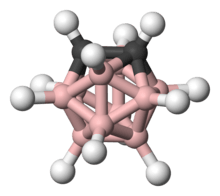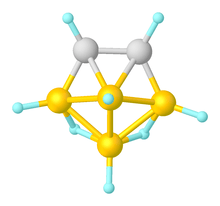Carborane

A carborane is a cluster composed of boron, carbon and hydrogen atoms. Like many of the related boranes, these clusters are polyhedra and are similarly classified as closo-, nido-, arachno-, hypho-, etc. based on whether they represent a complete (closo-) polyhedron, or a polyhedron that is missing one (nido-), two (arachno-), or more vertices. Carboranes are a notable example of heteroboranes.
The icosahedral closo-carboranes are particularly stable.[1] These boron-rich clusters exhibit unique organomimetic properties with chemical reactivity matching classical organic molecules, yet structurally similar to metal-based inorganic and organometallic species[2]
A prominent example is the charge-neutral C2B10H12 or ortho-carborane with the prefix o derived from ortho. This derivative has been considered for a wide range of applications from heat-resistant polymers to medical applications. The electronic structure of these cluster compounds has been described by Wade-Mingos rules. The chlorinated carborane acid H(CHB11Cl11) is a superacid.
Introduction
Carbaboranes are closely related to boranes. Stoichiometric and structural similarities and differences arise from the fact that a carbon atom has just one more valence electron than a boron atom. Consequently, whereas the boron hydride, B5H9, has a nido- structure the corresponding carbaborane, 1,5-C2B3H5 has a closo-, trigonal bipyramidal structure. Similarly, the carbaborane closo 1,6-C2B4H6 is isoelectronic and isostructural with the closo- borane anion B6H62-, whose core is a regular octahedron of boron atoms. Examples of nido and arachno- carbaboranes include 2,3-C2B4H8 and 1,3-C2B7H13, respectively. Geometrical isomers of carbaboranes may exist, necessitating the use of the numerical prefixes in a compound's name. For an overview of carbaborane chemistry see "Chemistry of the Elements", pp. 181–189[3]
Preparation
Carboranes are prepared by the addition of unsaturated carbon reagents to boron hydride clusters.
Monocarba derivatives
For monocarboranes, typical one-carbon reagents include cyanide, nitriles, isocyanides, and formaldehyde. For example, monocarbadodecaborane (CB11H13) is produced from decaborane and formaldehyde, followed by addition of borane dimethylsulfide[4]
Dicarba derivatives
Dicarbaboranes can be prepared from boron hydride clusters with an alkyne as the source of the two carbon centers. Examples of some known closo-dicarbaboranes are C2B3H5, C2B6H8, C2B7H9, and C2B8H10.

The preparation of the most famous carboranes, closo-dicarbadodecaboranes, uses acetylene as the C2 source and decaborane and the source of B10:
The discovery of these compounds is complicated. In the late 1950's and early 1960's I was working at Reaction Motors doing classified contract work on decaborane derivitaives for the Air force. We sent bi-weekly roports to the Air Force which circulated them to other contractors doing similar research among which was Olin Matheson. We prepared the first carborane derivitive (isopropenyl carborane, which I purified for analysis. I then prepared diacetoxymethyl carborane and hydrolyzed it to dihydroxymethyl carborane. This was the first carborane derivitive containing an active functional group. We reported this in our regular reports, but saw no mention of work at Olin Matheson till later, when several meetings were held with the Air Force. After two to Three years this work was declassified and allowed to be published. A meeting was held with the editors of Inorganic Chemistry with the aim of arranging priorities. I do not know how it was decided that the Olin group was given priority (perhaps a coin toss) and I have lost touch with all the other authors, but I recently saw that our work was no longer credited and would like to correct this.[6]
Heying, T. L.; Ager, J. W.; Clark, S. L.; Mangold, D. J.; Goldstein, H. L.; Hillman, M.; Polak, R. J.; Szymanski, J. W. (1963). "A New Series of Organoboranes. I. Carboranes from the Reaction of Decaborane with Acetylenic Compounds". Inorganic Chemistry. 2 (6): 1089–1092. doi:10.1021/ic50010a002. </ref>
- nido-B10H14 + 2SEt2 → B10H12(SEt2)2 + H2
- B10H12(SEt2)2 + C2H2→ closo-1,2-C2B10H12 +2SEt2 + H2
It melts, without decomposition, at 320 °C.
Isomerism
Dicarbaboranes often exist as isomers that differ with respect to the relative location of the carbon centers. For example, the reaction of pentaborane(9) with acetylene affords all three isomers:
- nido-B5H9 + C2H2 closo-1,5-C2B3H5, closo-1,6-C2B4H6, closo-2,4-C2B5H7
When the reaction is conducted at a lower temperatures, a nido-intermediate is obtained:
- nido-B5H9 + C2H2 nido-2,4-C2B4H8
Other procedures carboranes that three carbon atoms or four carbon atoms.[7]
1,2-C2B10H12 rearranges to form the 1,3-isomer. The para- isomer is produced by heating to temperatures above 600 °C.
Reactions
Closo-dicarbadodecaboranes can undergo a wide variety of organic chemistry reactions. Deprotonation using organolithium reagents gives the dilithio derivatives.[8]
- C2B10H12 + 2 BuLi → Li2C2B10H10 + 2 BuH
These dilithiated compounds react with a variety of electrophiles, e.g. chlorophosphines, chlorosilanes, and sulfur.[9]
Base-induced degradation of carboranes give anionic nido derivatives that are used as ligands. The great majority of the work has been conducted on derivatives of ortho carborane, but larger carboranes have also been investigated.[10]
Research
Dicarbollide complexes have been evaluated for many applications but few have been commercialized. The bis(dicarbollide) [Co(C2B9H11)2]- has been used as a precipitant for removal fo 137Cs+ from radiowastes.[11]
The medical applications of carboranes have been explored.[12] C-functionalized carboranes represent a source of boron forboron neutron capture therapy.[13]
Some complexes exhibit catalytic properties,[14] ion-exchange materials for radioactive waste management.
The compound H(CHB11Cl11) can be classed as a superacid.[15] It protonate fullerene, C60.[16] Additionally, it is the only known anion capable of forming a stable, isolable salt with protonated benzene, C6H+
7.
See also
References
- ↑ Jemmis, E. D. (1982). "Overlap control and stability of polyhedral molecules. Closo-Carboranes". Journal of the American Chemical Society. 104 (25): 7017–7020. doi:10.1021/ja00389a021.
- ↑ Spokoyny, A. M. (2013). "New ligand platforms featuring boron-rich clusters as organomimetic substituents". Pure and Applied Chemistry. 85 (5): 903–919. doi:10.1351/PAC-CON-13-01-13. PMC 3845684.
- ↑ Greenwood, Norman N.; Earnshaw, Alan (1997). Chemistry of the Elements (2nd ed.). Butterworth-Heinemann. ISBN 0-08-037941-9.
- ↑ Tanaka, N.; Shoji, Y.; Fukushima, T. (2016). "Convenient Route to Monocarba-closo-dodecaborate Anions". Organometallics. 35: 2022–2025. doi:10.1021/acs.organomet.6b00309.
- ↑ G. S. Pawley (1966). "Further Refinements of Some Rigid Boron Compounds". Acta Crystallogr. 20: 631–638. doi:10.1107/S0365110X66001531.
- ↑ J. Inorg Chem. II(6),1101,1115,1120,1125,(1963) Nelson. N. Schwartz.
- ↑ Greenwood, Norman N.; Earnshaw, Alan (1997). Chemistry of the Elements (2nd ed.). Butterworth-Heinemann. ISBN 0-08-037941-9. p183
- ↑ Popescu, A.-R.; Musteti, A. D.; Ferrer-Ugalde, A.; Viñas, C.; Núñez, R.; Teixidor, F. (2012). "Influential Role of Ethereal Solvent on Organolithium Compounds: The Case of Carboranyllithium". Chemistry – A European Journal. 18: 3174–3184. doi:10.1002/chem.201102626.
- ↑ Jin, G.-X. (2004). "Advances in the Chemistry of Organometallic Complexes with 1,2-Dichalcogenolato-o-Carborane Ligands". Coord. Chem. Rev. 248: 587–602. doi:10.1016/j.ccr.2004.01.002.
- ↑ Deng, L.; Xie, Z. (2007). "Advances in the Chemistry of carboranes and metallacarboranes with more than 12 vertices". Coord. Chem. Rev. 251: 2452–2476. doi:10.1016/j.ccr.2007.02.009.
- ↑ Dash, B. P.; Satapathy, R.; Swain, B. R.; Mahanta, C. S.; Jena, B. B.; Hosmane, N. S. (2017). "Cobalt bis(dicarbollide) anion and its derivatives". J. Organomet. Chem. 849-850: 170–194. doi:10.1016/j.jorganchem.2017.04.006.
- ↑ Issa, F.; Kassiou, M.; Rendina, L. M. (2011). "Boron in drug discovery: carboranes as unique pharmacophores in biologically active compounds". Chem. Rev. 111: 5701–5722. doi:10.1021/cr2000866.
- ↑ Soloway, A. H.; Tjarks, W.; Barnum, B. A.; Rong, F.-G.; Barth, R. F.; Codogni, I. M.; Wilson, J. G. (1998). "The Chemistry of Neutron Capture Therapy". Chemical Reviews. 98 (4): 1515–1562. doi:10.1021/cr941195u. PMID 11848941.
- ↑ Crowther, D. J.; Baenziger, N. C.; Jordan, R. F. (1991). "Group 4 metal dicarbollide chemistry. Synthesis, structures and reactivity of electrophilic alkyl complexes (Cp*)(C2B9H11)M(R), M = Hf, Zr". Journal of the American Chemical Society. 113 (4): 1455–1457. doi:10.1021/ja00004a080.
- ↑ Olah, G. A.; Prakash, G. K. S.; Sommer, J.; Molnar, A. (2009). Superacid Chemistry (2nd ed.). Wiley. p. 41. ISBN 978-0-471-59668-4.
- ↑ Reed Christopher A (2013). "Myths about the Proton. The Nature of H+ in Condensed Media". Acc. Chem. Res. 46 (11): 2567–2575. doi:10.1021/ar400064q. PMC 3833890. PMID 23875729.